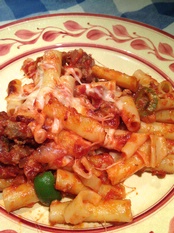|
|
 |

Jan 6, 2015
WINE WITH…Baked Ziti
Some dishes are so iconic, so carved in stone (or perhaps pasta) that even minor changes to the basic ingredients turns them into something different--not bad necessarily, just different. For Americans of a certain age, baked ziti is one such dish. Like spaghetti-and-meatballs, another favorite item from the Italian-American repertoire of nostalgic gastronomy, baked ziti can be tricked out with all kinds of tasty embellishments. Add a drizzle of pesto? Sure. A layer of artichoke hearts? Go ahead. Pork belly? Yum. These are undoubtedly delicious additions, but any one of them changes the simple rustic character and straightforward flavors of baked ziti. pesto? Sure. A layer of artichoke hearts? Go ahead. Pork belly? Yum. These are undoubtedly delicious additions, but any one of them changes the simple rustic character and straightforward flavors of baked ziti.
And yet, the temptation to add a tiny flourish of flavor can be irresistible, especially when one is seeking a dish that is not only true to its origins but that also offers elevated and more complex tastes that will make the ziti a wonderful companion to a broad range of wines. Eggplant might be a good addition, adding both subtle flavor and velvety texture, but in this instance we decided to go with olives.
Baked ziti bears a strong resemblance to lasagna but it is infinitely simpler to prepare, and it can be made several hours ahead of time and baked just before serving.
Baked Ziti
Serves 6
Preheat oven to 400°
One pound hot Italian sausage*
1 tablespoon olive oil
1 medium onion, minced
3 cloves garlic, minced
1 teaspoon thyme
½ cup red wine
1 28-ounce can crushed tomatoes
Salt and pepper
1 pound ziti
About 15-20 pitted green olives such as Castelvetrano**
1 pound fresh mozzarella, shredded
1 cup grated Parmesan cheese
Unless you are using bulk sausage, remove the casings and crumble the sausage. Place it in a large sauté pan, preferably nonstick, and brown the sausage, stirring frequently. Transfer it to a plate lined with paper towels to soak off the fat.
Discard the grease from the skillet and add the olive oil. Add the onion and cook until it is soft; then add the garlic and thyme and cook for another couple of minutes. Pour in the wine, turn up the heat and cook for about 3 minutes, or until the wine has been almost completely absorbed. Stir in the tomatoes and the cooked sausage and simmer for 15-20 minutes. Meanwhile cook the pasta in plenty of salted water according to package directions.
When the pasta is done, drain it; then transfer it back to the cooking pot or to a large bowl, and add the sausage mixture. Stir the olives into the pasta (if they are large halve them).
Spread half the pasta mixture into a lightly oiled 9X13 inch baking dish. Sprinkle with half the mozzarella and half the Parmesan cheeses. Add the remaining pasta and top with the remaining cheeses. Drizzle the top lightly with olive oil for more intense browning. Transfer the dish to the oven and bake for 20-40 minutes or until it is sizzling and browned (if the dish has been assembled earlier and stored in the refrigerator it will take more time to cook).
*We prefer hot to sweet sausage as the heightened flavors play off red wine more agreeably.
**You could use Kalamata or other black or green olives, thought the taste will be different.
* * *
Baked ziti calls for a red wine, one with forceful flavors and tangy acidity to match the spicy sausage and zesty tomato sauce. We tried thirteen different reds with our version, and only the most delicate performed poorly. (Forget Beaujolais and subtle Pinots.) Since baked ziti is also a favorite comfort food dish, best suited to weekday suppers rather than fancy dinner parties, we limited our choices to wines costing less than $30, with the majority carrying price tags under $20. With one notable exception, all of our favorites are value-priced under $15.
Selection
|
Approx. Price
|
Comments
|
Bogle Vineyards, California Zinfandel “Old Vine” 2011
|
$11
|
A surprisingly sophisticated Zin, sourced from well-established vineyards in both Amador and Lodi, this spicy but not excessively sweet wine meshed very nicely with the forward, equally spicy flavors of the dish.
|
Caparzo, Tuscany (Italy) Sangiovese Toscana 2012
(Imported by Vineyard Brands)
|
$14
|
Fresh and bright, with a firm acidic backbone, this is a vibrant expression of Tuscany’s signature grape variety. It’s very much a food wine, as the pairing brings out nuances that one may miss if sipping it on its own.
|
Cono Sur, Valle del Maipo (Chile) Cabernet Sauvignon “Reserva Especial” 2012
(Imported by Vineyard Brands)
|
$14
|
A powerful Cabernet that clearly outperforms its modest price, this wine has a green, herbal edge that adds complexity and sophistication. It serves as a reminder that the central valleys of Chile offer some of the best values in Cabernet to be found anywhere.
|
Tooth & Nail, Paso Robles (California) “The Fiend” 2012
|
$27
|
A blend of Malbec and Syrah, this is an extremely enjoyable wine, full of flavor without unnecessary heat, alcohol, or other excess. It married wonderfully with the array of flavors in this dish (showing a special affinity for the olives). The most expensive wine we’re recommending, it’s worth the extra money.
|
Truffle Hunter, Barbera d’Asti (Italy) “Leda” 2013
(Imported by Quintessential)
|
$13
|
Named for a truffle-hunting dog, Leda tastes true to its origins. It exhibits both Barbera’s juiciness and Piedmont’s earthiness, and so is a fine bargain.
|
|
 |
|